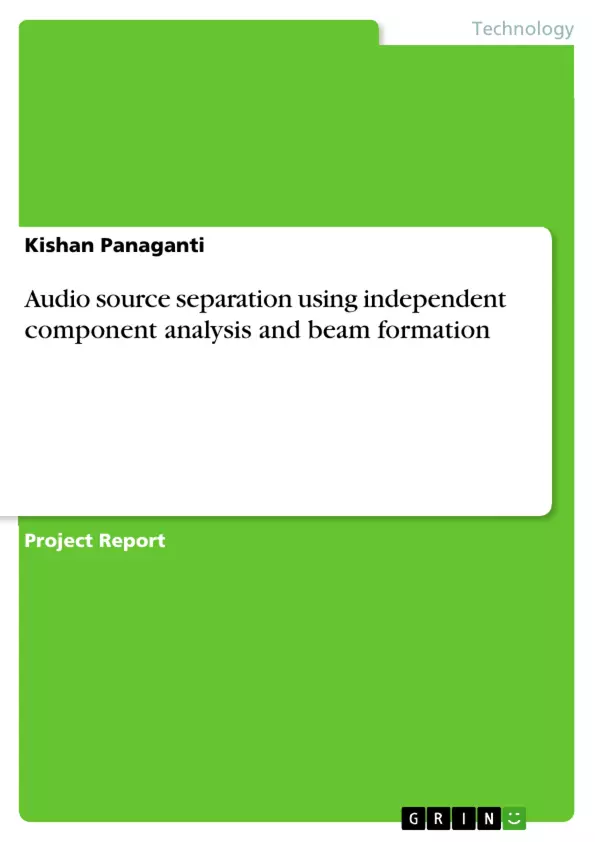Audio source separation is the problem of automated separation of audio sources present in a room, using a set of differently placed microphones, capturing the auditory scene. The whole problem resembles the task a human can solve in a cocktail party situation, where using two sensors (ears), the brain can focus on a specific source of interest, suppressing all other sources present (cocktail party problem).
For computational and conceptual simplicity this problem is often represented as a linear transformation of the original audio signals. In other words, each component (multivariate signal) of the representation is a linear combination of the original variables (original subcomponents).
In signal processing, independent component analysis (ICA) is a computational method for separating a multivariate signal into additive subcomponents by assuming that the subcomponents are non-Gaussian signals and that they are all statistically independent from each other. Such a representation seems to capture the essential structure of the data in many applications.
Here we separate audio using different criteria suggested for ICA, being PCA (Principal Component Analysis), Non-gaussianity maximization using kurtosis and neg-entropy methods, frequency domain approach using non-gaussianity maximization and beamforming.
Inhaltsverzeichnis (Table of Contents)
- 1. MOTIVATION
- 2: INDEPENDENT COMPONENT ANALYSIS
- 2.1 – DEFINITION OF ICA
- 2.2 ESTIMATION OF ICA
- 2.3 AMBIGUITIES OF ICA
- 2.4 ILLUSTRATION
- 3. ASSUMPTIONS
- 4. ICA ESTIMATION USING NON-GAUSSIANITY MAXIMIZATION
- 4.1- PRINCIPLE
- 4.2 - KURTOSIS AS A MEASURE OF NON GAUSSIANITY
- 4.3- NEGENTROPY AS A MEASURE OF NONGAUSSIANITY
- 4.3.1 APPROXIMATION OF NEGENTROPY
- 5. FREQUENCY DOMAIN APPROACH
- 6. ACOUSTIC BEAM FORMATION
- 7. RESULTS
- 7.1 WHITENING AND PCA
- 7.2 NEGENTROPY METHOD
- 7.2.1 TIME DOMAIN ANALYSIS
- 7.2.2 FREQUENCY DOMAIN ANALYSIS
- 7.3 ACOUSTIC BEAM FORMING
- 8. REFERENCES
Zielsetzung und Themenschwerpunkte (Objectives and Key Themes)
This work aims to address the challenge of separating audio sources in a room using multiple microphones. The problem, akin to the cocktail party effect, involves isolating a desired audio source while suppressing other simultaneous sources.
- Independent Component Analysis (ICA)
- Acoustic Beam Formation
- Non-Gaussianity Maximization
- Time and Frequency Domain Analysis
- Principal Component Analysis (PCA)
Zusammenfassung der Kapitel (Chapter Summaries)
The work begins by introducing the motivation behind audio source separation and the conceptual framework of the problem. This is followed by a detailed explanation of Independent Component Analysis (ICA), a computational technique crucial to the separation process. The text delves into the theoretical underpinnings of ICA, including its definition, estimation methods, inherent ambiguities, and illustrative examples.
The paper then elaborates on the assumptions underlying ICA, highlighting the significance of non-Gaussianity in achieving effective separation. The subsequent section explores the estimation of ICA based on maximizing non-Gaussianity. The key measures of non-Gaussianity, kurtosis and negentropy, are presented along with methods for approximating negentropy.
The text then moves on to examine the frequency domain approach to audio source separation, offering an alternative method for separating sources. The work concludes with a detailed discussion of acoustic beamforming, a technique used to focus sound from a specific direction while minimizing interference from other sources.
Schlüsselwörter (Keywords)
Audio source separation, Independent Component Analysis (ICA), Acoustic Beam Formation, Non-Gaussianity, Kurtosis, Negentropy, Frequency Domain Analysis, Principal Component Analysis (PCA), Cocktail Party Problem.
- Quote paper
- Kishan Panaganti (Author), 2013, Audio source separation using independent component analysis and beam formation, Munich, GRIN Verlag, https://www.hausarbeiten.de/document/267455


